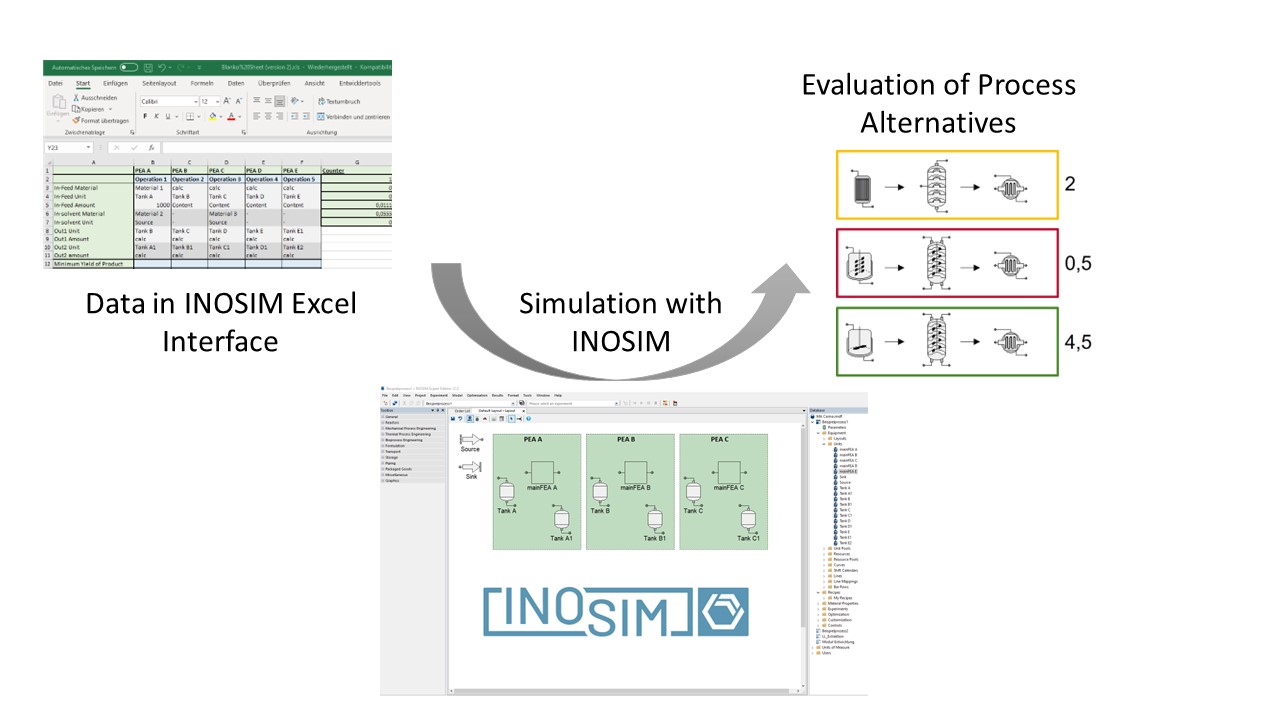Multi-level Process Development Methodology
A methodology for the simulation-based evaluation of modularized plant alternatives
Particularly in fine and specialty chemicals, due to their small production volumes, a rapid response to market changes is necessary. Here, the use of modular components, so-called PEAs (Process Equipment Assembly), which are considered to be particularly flexible, is therefore advantageous. In order to exploit the flexibility of such plants, new process development methods have to be created that allow plant designers to select the best plant alternative on the basis of an available PEA park [1].
Within the research area SkaMPi (Multi-level Methodology For The Planning And Development Of Resource-Efficient Processes) of the ENPRO2 project, a selection methodology was developed for the efficient planning of such modularized plants. With the help of the process simulation software Inosim, which is widely established in the process industries, it is possible to automatically evaluate various plant alternatives quantitatively on the basis of a multi-criteria evaluation system and to make the results available to the plant designers in tabular form for the final decision.
Generic implementation of different process structures
To implement the methodology, a generic process structure was first created in the simulation software. It is used to depict various processes by different parameterizations. The generic process structure contains placeholders for the process equipment, the so-called MainFEAs (main functional unit of the PEAs). In addition, generic buffer tanks are implemented, which can be used between the MainFEAs. This structure can be interconnected and expanded as desired.
Parameterization via Excel
The Excel interface integrated in Inosim is used to define the process and the plant alternatives. In this method, the data required for the simulation and evaluation of plant alternatives come from three sources. The block flow diagram shows how the PEAs are interconnected and how the process flows between them are defined. This data determines how the placeholders for the PEAs are connected in the generic process structure. With the help of the so-called matching matrix[1], it is possible to classify different unit technologies for a process step on the basis of technical and evaluation criteria. This matrix is specific to a basic operation, e.g., extraction.
Different technologies are then evaluated for their suitability for the defined problem. Various technical criteria, such as the substance system used, and evaluation criteria, such as costs, are taken into account. With the help of these criteria, a selection of unit technologies for a process step is obtained. This selection results in several plant alternatives, which are compared with each other in this method. As a third source, the design and operation parameters of the PEAs are used, which may result from an existing PEA park.

Evaluation of plant alternatives
From the data, an automated simulation and evaluation of the alternatives resulting from the matching matrix and the PEA park is executed in the INOSIM process simulator with the help of shortcut models. These criteria are based on the criteria already used in the matching matrix for individual units and are applied to the entire process. Included are equipment, energy and staff costs, but also quality criteria and capacity limits. As a result, the plant designer receives a tabular evaluation for each plant alternative, in which both the different criteria individually and an overall evaluation are issued. Furthermore, an individual weighing of evaluation criteria can be done.
Uncertain process parameters
In addition to the simple evaluation of the alternatives, the methodology also makes it possible to determine the influence of uncertain input parameters on the evaluation of the alternative. Thus, especially at the beginning of process development, the impact of unknown parameters on the overall evaluation is determined. The user can assign a probability distribution to input parameters and parameterize them via the Excel interface. Sensitivity analysis is then used to determine the influence of the parameters on the evaluation and to determine whether an uncertainty in the parameters may lead to a failure in meeting target KPIs for the process.
The method, with its entire workflow from data collection and identification of potential PEAs to multi-criteria evaluation and evaluation of uncertain process parameters, has been applied to industrial processes. The entire workflow is displayed in the picture. For the processes analysed, the most suitable units for the respective process steps could be selected and the preferred process design determined. The results obtained in the research project suggest that the described methodology will also lead to more flexible, market-oriented plants in the later industrial application of modular components.
The research project SkaMPi is part of the ENPRO2 project and was funded by the Federal Ministry for Economic Affairs and Energy under the grant code 03ET1525C. Responsibility for the content of this publication rests with the author.
Reference
[1] Schindel; Polyakova; Harding; Weinhold; Stenger; Grünewald; Bramsiepe (2021): General approach for technology and Process Equipment Assembly (PEA) selection in process design. In: Chem. Eng. Process. 159, S. 108223. DOI: 10.1016/j.cep.2020.108223.
Author: Carina Glanemann-Heitkämper, Inosim Consulting
Downloads
Contact
INOSIM Consulting GmbH
Joseph-von-Fraunhofer-Str 20
44227 Dortmund
+49 231 9700-250









